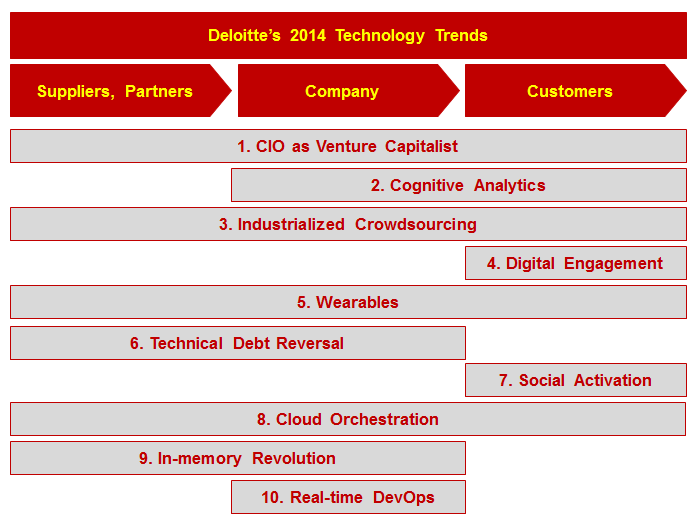Deloitte published its 5th annual Top 10 technology trends recently here. It’s 137 pages, but very readable. Deloitte included lots of client interviews and real-life examples. They kept the consulting-y talk to a minimum. Thank you.
Even if you don’t specialize in technology (I don’t), it’s important to stay “in-the-know” and relevant. As I tell people, “you are getting old when you start to fear technology.”
Technology touches every project
Whether it is the data extracts we get during the assessment phase, or changes we recommend to automate manual processes, technology is often a part of the recommendation. Often times, we need to coach the client to get more use out of the legacy software they already have.
For me, I am usually dealing with enterprise-sized software platforms (SAP, Oracle), or the business intelligence platforms that help our teams to extract transactional data (e.g., Cognos, BusinessObjects, Essebase), or visualization programs (e.g., Tableau, ProModel). Fairly corporate stuff, but this report is WAY more interesting than that. . .
Top 10 trends are more fun
They cover a wide spectrum of areas varying from #5 wearable sensors that are constantly spinning off data, to #8 stitching together the different cloud applications that help to run the business.
In an effort to summarize 137 pages in one graphic, I took a guesstimate on how each of the trends applies across the value chain. If you put your company in the middle, how do the trends apply to your suppliers and partners (the inputs to your business) shown on the left, and your customers (the output of your processes) on the right. Feel free to push-back on this summary, but this is how I see it.
- Four of the trends (#1,#3,#5,#8) are the broadest and span all areas
- Digital engagement and social activation are very customer-centric

#1 CIO as venture capitalist
This is a fascinating concept because IT departments, and those CIOs who run them, are notoriously conservative. They typically do not want to do anything that will rock the boat, cause system downtime, or be blamed for any slow-down in the technology that helps to run the business. If you have ever been on a system implementation, or upgrade, you know that CIOs are super-cautious, and spend most of their time mitigating risk. Slow moving, not so innovative.
So this is pretty provocative stuff. CIO as venture capitalist. Managing a portfolio of technologies and projects. Judging risks and rewards and looking for 2x, 3x, 4x returns from technology investment. This is radical thinking. A real non-linear view of enterprise IT; it’s more than just extending legacy systems. Learning to take risks. Placing multiple bets. Creating a culture that accepts (small, non-lethal) failures and allows innovation. From the CIO survey in 2013, there was a demand for IT talent who think strategically, in business terms, and know how to communicate.
This is a tall order from the IT department, and also from CIO. As consultants, we need to be forward-thinking. We learn from the top 10% of our highest performing clients. For the other 90% of clients, we need to lead. More innovative and disruptive thinking. Time to push and motivate that CIO you know to think like a VC.
Deloitte Tech Trends 2014: Inspiring Disruption here
